Impulse and Performance Measurements of Electric Solid Propellant in a Laboratory Electrothermal Ablation-Fed Pulsed Plasma Thruster
Abstract
1. Introduction
2. Methods and Apparatus
2.1. High-Performance Electric Propellant
2.2. Electric Propellant Thruster Experiment
2.2.1. Geometry and Operation
2.2.2. Thrust Mode
2.3. Compact Thrust Stand
3. Results
3.1. Short-Duration Tests
3.2. Long-Duration Tests
4. Analysis and Discussion
4.1. Very Short Duration Tests
4.2. Specific Impulse
4.3. Thrust Mode Verification
5. Conclusions
Author Contributions
Funding
Acknowledgments
Conflicts of Interest
References
- Sawka, W.N.; McPherson, M. Electrical Solid Propellants: A Safe, Micro to Macro Propulsion Technology. In Proceedings of the 49th Joint Propulsion Conference, San Jose, CA, USA, 14–17 July 2013. [Google Scholar]
- Sawka, W.N. Controllable Digital Solid State Cluster Thrusters for Rocket Propulsion and Gas Generation. U.S. Patent 8464640, 18 June 2013. [Google Scholar]
- Dulligan, M. Electrically Controlled Extinguishable Solid Propellant Motors. U.S. Patent 7788900B2, 7 September 2010. [Google Scholar]
- Chung, K.; Rozumov, E.; Kaminsky, D.; Buescher, T.; Manship, T.; Valdivia, A.; Cook, P.; Anderson, P. Development of Electrically Controlled Energetic Materials. ECS Trans. 2013, 50, 59–66. [Google Scholar] [CrossRef]
- Grix, C.; Sawka, W.N. Family of Modifiable High Performance Electrically Controlled Propellants and Explosives. U.S. Patent 8888935B2, 18 November 2014. [Google Scholar]
- Sawka, W.N.; Grix, C. Family of Metastable Intermolecular Composites Utilizing Energetic Liquid Oxidizers with Nanoparticle Fuels in Sol-Gel Polymer Network. U.S. Patent 8317953B2, 27 November 2012. [Google Scholar]
- Baird, J.K.; Lang, J.R.; Hiatt, A.T.; Frederick, R.A. Electrolytic Combustion in the Polyvinyl Alcohol Plus Hydroxylammonium Nitrate Solid Propellant. J. Propul. Power 2017, 33, 1589–1590. [Google Scholar] [CrossRef]
- Hiatt, A.T.; Frederick, R.A. Laboratory Experimentation and Basic Research Investigation Electric Solid Propellant Electrolytic Characteristics. In Proceedings of the 52nd AIAA/SAE/ASEE Joint Propulsion Conference, Salt Lake City, UT, USA, 25–27 July 2016. [Google Scholar]
- Sawka, W.N.; Grix, C. Electrode Ignition and Control of Electrically Ignitable Materials. U.S. Patent 8857338B2, 14 October 2014. [Google Scholar]
- Burton, R.L.; Turchi, P.J. Pulsed Plasma Thruster. J. Propul. Power 1998, 14, 716–735. [Google Scholar] [CrossRef]
- Gatsonis, N.A.; Lu, Y.; Blandino, J.; Demetriou, M.A.; Paschalidis, N. Micropulsed Plasma Thrusters for Attitude Control of a Low-Earth-Orbiting CubeSat. J. Spacecr. Rockets 2016, 53, 57–73. [Google Scholar] [CrossRef]
- Keidar, M.; Zhuang, T.; Shashurin, A.; Teel, G.; Chiu, D.; Lukas, J.; Haque, S.; Brieda, L. Electric Propulsion for Small Satellites. Plasma Phys. Control. Fusion 2015, 57, 1–10. [Google Scholar] [CrossRef]
- Bushman, S.; Burton, R.L. Heating and Plasma Properties in a Coaxial Gasdynamic Pulsed Plasma Thruster. J. Propul. Power 2001, 17, 959–966. [Google Scholar] [CrossRef]
- Cheng, L.; Wang, Y.; Ding, W.; Ge, C.; Yan, J.; Li, Y.; Li, Z.; Sun, A. Experimental Study on the Discharge Ignition in a Capillary Discharge Based Pulsed Plasma Thruster. Phys. Plasma 2018, 25, 093512. [Google Scholar] [CrossRef]
- Wang, Y.; Ding, W.; Cheng, L.; Yan, J.; Li, Z.; Wang, J.; Wang, Y. An Investigation of Discharge Characteristics of an Electrothermal Pulsed Plasma Thruster. IEEE Trans. Plasma Sci. 2017, 45, 2715–2724. [Google Scholar] [CrossRef]
- Aoyagi, J.; Mukai, M.; Kamishima, Y.; Sasaki, T.; Shintani, K.; Takegahara, H.; Wakizono, T.; Sugiki, M. Total Impulse Improvement of Coaxial Pulsed Plasma Thruster for Small Satellite. Vacuum 2008, 83, 72–76. [Google Scholar] [CrossRef]
- Edamitsu, T.; Tahara, H. Experimental and Numerical Study of an Electrothermal Pulsed Plasma Thruster for Small Satellites. Vacuum 2006, 80, 1223–1228. [Google Scholar] [CrossRef]
- Miyasaka, T.; Asato, K.; Sakaguchi, N.; Ito, K. Optical Measurements of Unsteady Phenomena on Coaxial Pulsed Plasma Thrusters. Vacuum 2013, 88, 52–57. [Google Scholar] [CrossRef]
- Montag, C.; Herdrich, G.; Amo, J.G.d.; Bauer, P.; Feyhl, D. PETRUS 2.0 PPT and its CubeSat-size PPU: Testing and Characterization. In Proceedings of the 36th International Electric Propulsion Conference, Vienna, Austria, 15–20 September 2019. [Google Scholar]
- Markusic, T.E.; Polzin, K.A.; Choueiri, E.Y.; Keidar, M.; Boyd, I.D.; Lepsetz, N. Ablative Z-Pinch Pulsed Plasma Thruster. J. Propul. Power 2005, 21, 392–400. [Google Scholar] [CrossRef]
- Keidar, M.; Boyd, I.D.; Beilis, I.I. Electrical Discharge in the Teflon Cavity of a Coaxial Pulsed Plasma Thruster. IEEE Trans. Plasma Sci. 2000, 28, 376–385. [Google Scholar] [CrossRef]
- Keidar, M.; Boyd, I.D.; Beilis, I.I. Model of an Electrothermal Pulsed Plasma Thruster. J. Propul. Power 2003, 19, 424–430. [Google Scholar] [CrossRef]
- Ruchti, C.B.; Niemeyer, L. Ablation Controlled Arcs. IEEE Trans. Plasma Sci. 1986, PS-14, 423–434. [Google Scholar] [CrossRef]
- Schönherr, T.; Komurasaki, K.; Herdrich, G. Propellant Utilization Efficiency in a Pulsed Plasma Thruster. J. Propul. Power 2013, 29, 1478–1487. [Google Scholar] [CrossRef]
- Seeger, M.; Tepper, J.; Christen, T.; Abrahamson, J. Experimental Study on PTFE Ablation in High Voltage Circuit-Breakers. J. Phys. D Appl. Phys. 2006, 39, 5016–5024. [Google Scholar] [CrossRef]
- Wang, W.; Kong, L.; Geng, J.; Wei, F.; Xia, G. Wall Ablation of Heated Compound-Materials into Non-Equilibrium Discharge Plasmas. J. Phys. D Appl. Phys. 2017, 50, 074005. [Google Scholar] [CrossRef]
- Glascock, M.S.; Rovey, J.L.; Polzin, K.A. Electric Solid Propellant Ablation in an Arc Discharge. J. Propul. Power 2019, 1–10. [Google Scholar] [CrossRef]
- Glascock, M.S.; Rovey, J.L.; Williams, S.; Thrasher, J. Plume Characterization of Electric Solid Propellant Pulsed Microthrusters. J. Propul. Power 2017, 33, 870–880. [Google Scholar] [CrossRef]
- Glascock, M.S. Characterization of Electric Solid Propellant Pulsed Microthrusters. Master’s Thesis, Missouri University of Science and Technology, Rolla, MO, USA, 2016. [Google Scholar]
- Glascock, M.S.; Drew, P.D.; Rovey, J.L.; Polzin, K.A. Thermodynamic Properties of Hydroxylammonium Nitrate-Based Electric Solid Propellant Plasma. J. Therophys. Heat Transf. 2020, 1–8. [Google Scholar] [CrossRef]
- Glascock, M.S.; Rovey, J.L.; Williams, S.; Thrasher, J. Observation of Late-Time Ablation in Electric Solid Propellant Pulsed Microthrusters. In Proceedings of the 52nd AIAA/SAE/ASEE Joint Propulsion Conference, Salt Lake City, UT, USA, 25–27 July 2016. [Google Scholar]
- Goldston, R.J.; Rutherford, P.H. Introduction to Plasma Physics; Taylor & Francis Group: New York, NY, USA, 1995. [Google Scholar]
- Wilson, M.J.; Bushman, S.; Burton, R.L. A Compact Thrust Stand for Pulsed Plasma Thrusters. In Proceedings of the 25th International Electric Propulsion Conference, Cleveland, OH, USA, 24–28 August 1997. [Google Scholar]
- Polk, J.E.; Pancotti, A.; Haag, T.; King, S.; Walker, M.L.R.; Blakely, J.; Ziemer, J. Recommended Practice for Thrust Measurement in Electric Propulsion Testing. J. Propul. Power 2017, 33, 539–555. [Google Scholar] [CrossRef]
- Keidar, M.; Boyd, I.D.; Antonsen, E.L.; Burton, R.L.; Spanjers, G.G. Optimization Issues for a Micropulsed Plasma Thruster. J. Propul. Power 2006, 22, 48–55. [Google Scholar] [CrossRef]
- Keidar, M.; Boyd, I.D.; Antonsen, E.L.; Gulczinski, F.S., III; Spanjers, G.G. Propellant Charring in Pulsed Plasma Thrusters. J. Propul. Power 2004, 20, 978–984. [Google Scholar] [CrossRef]
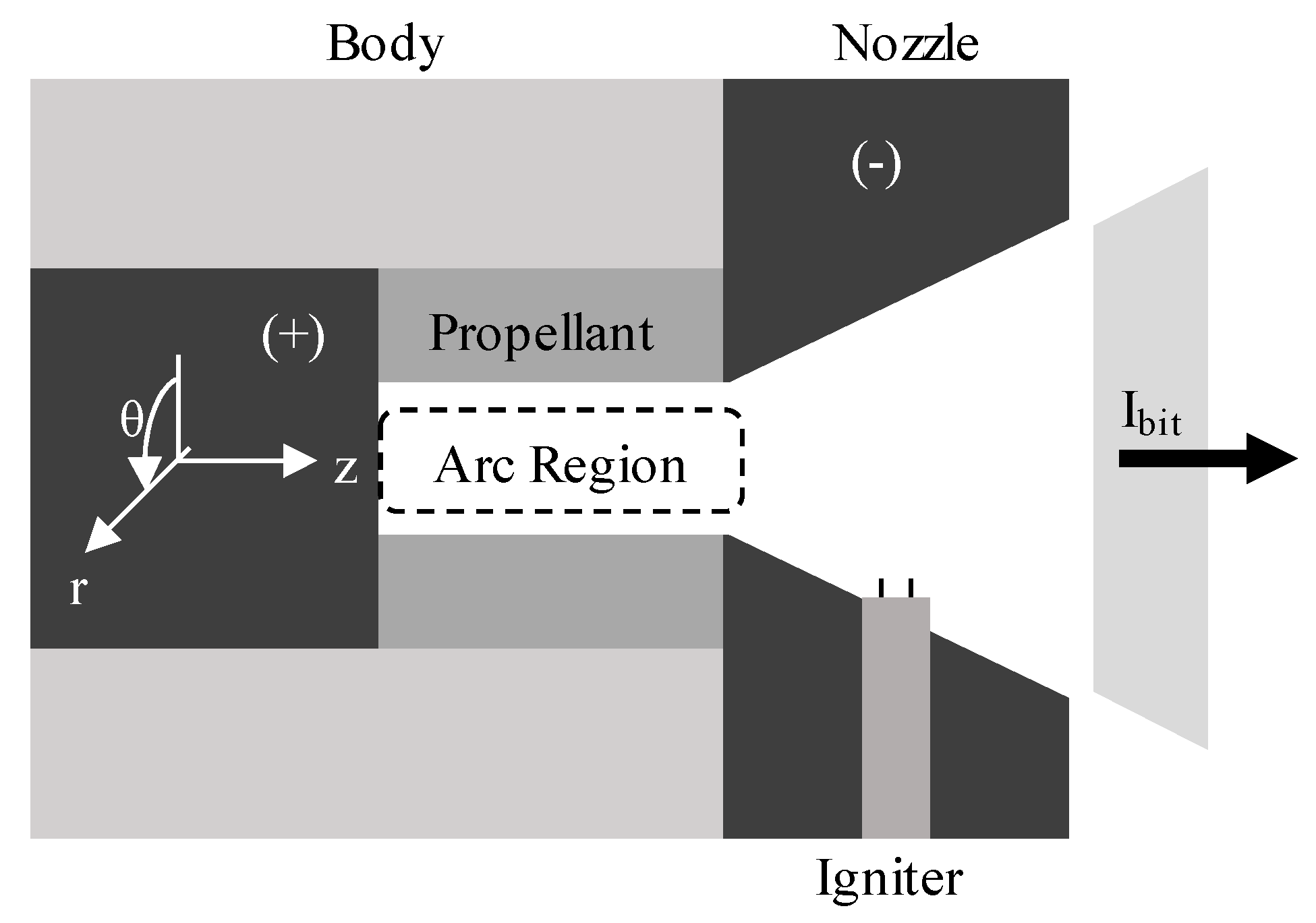
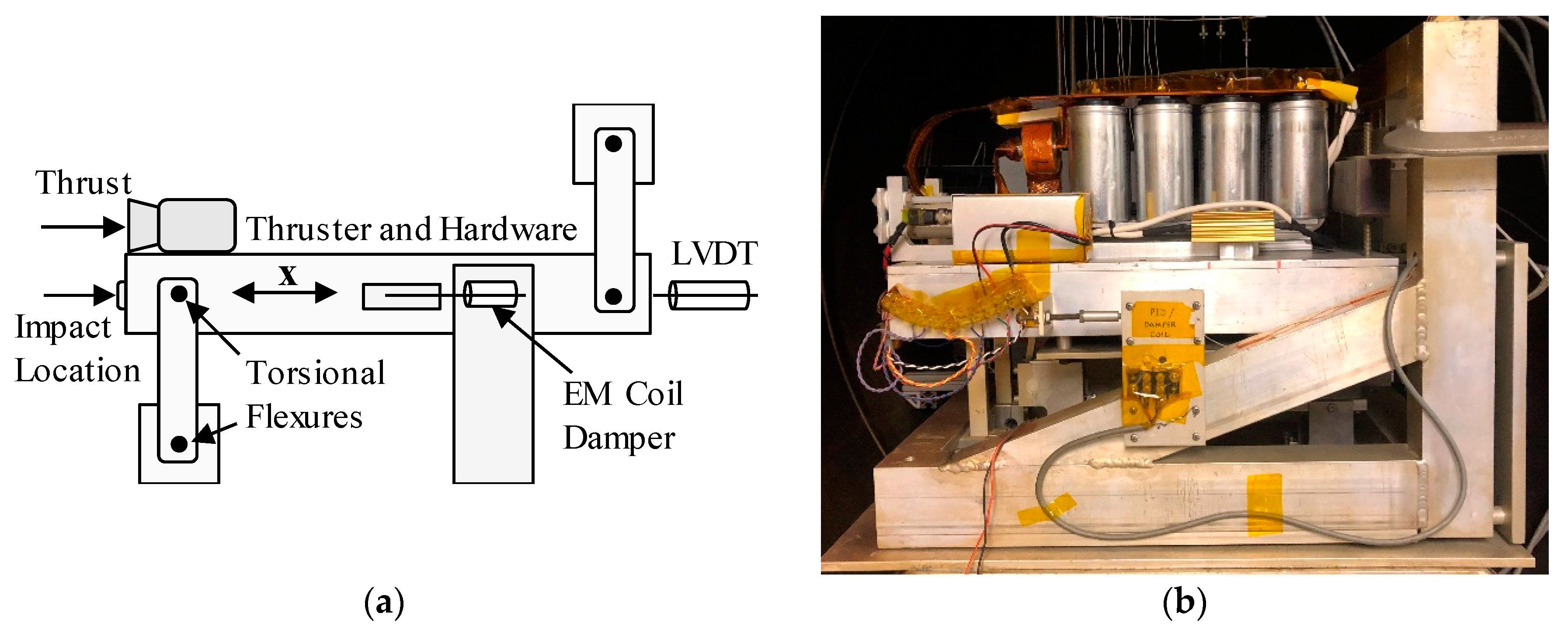
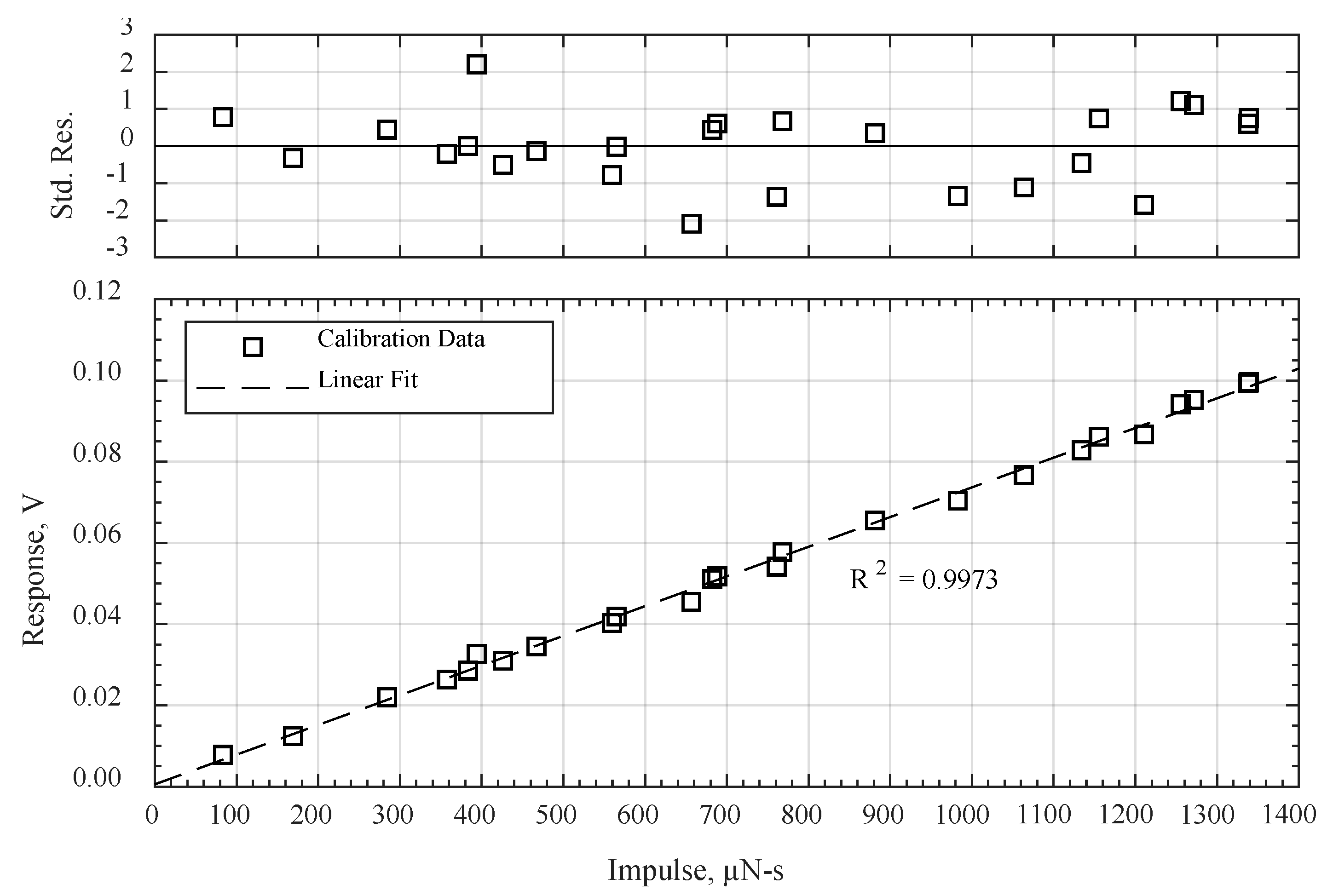
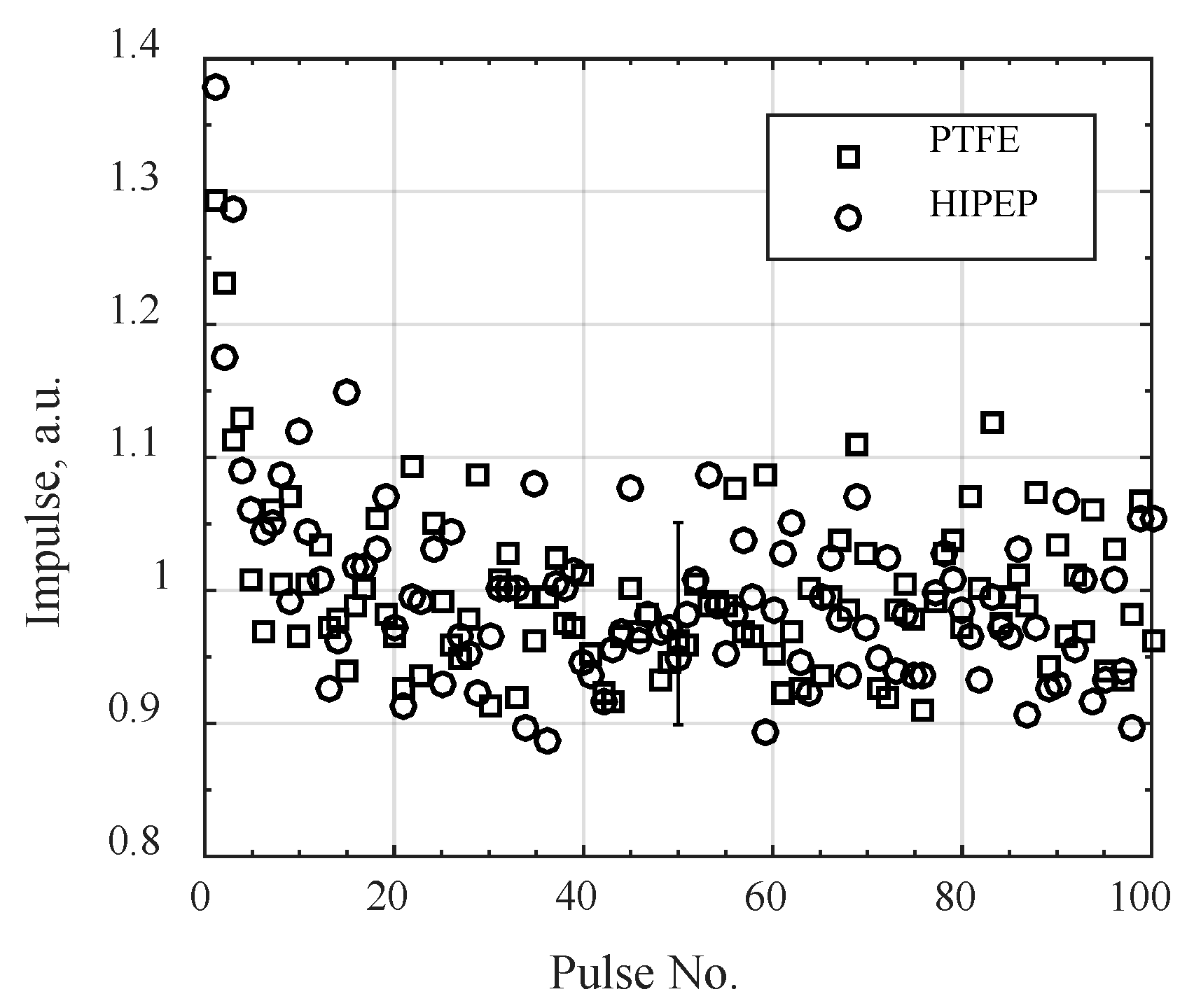

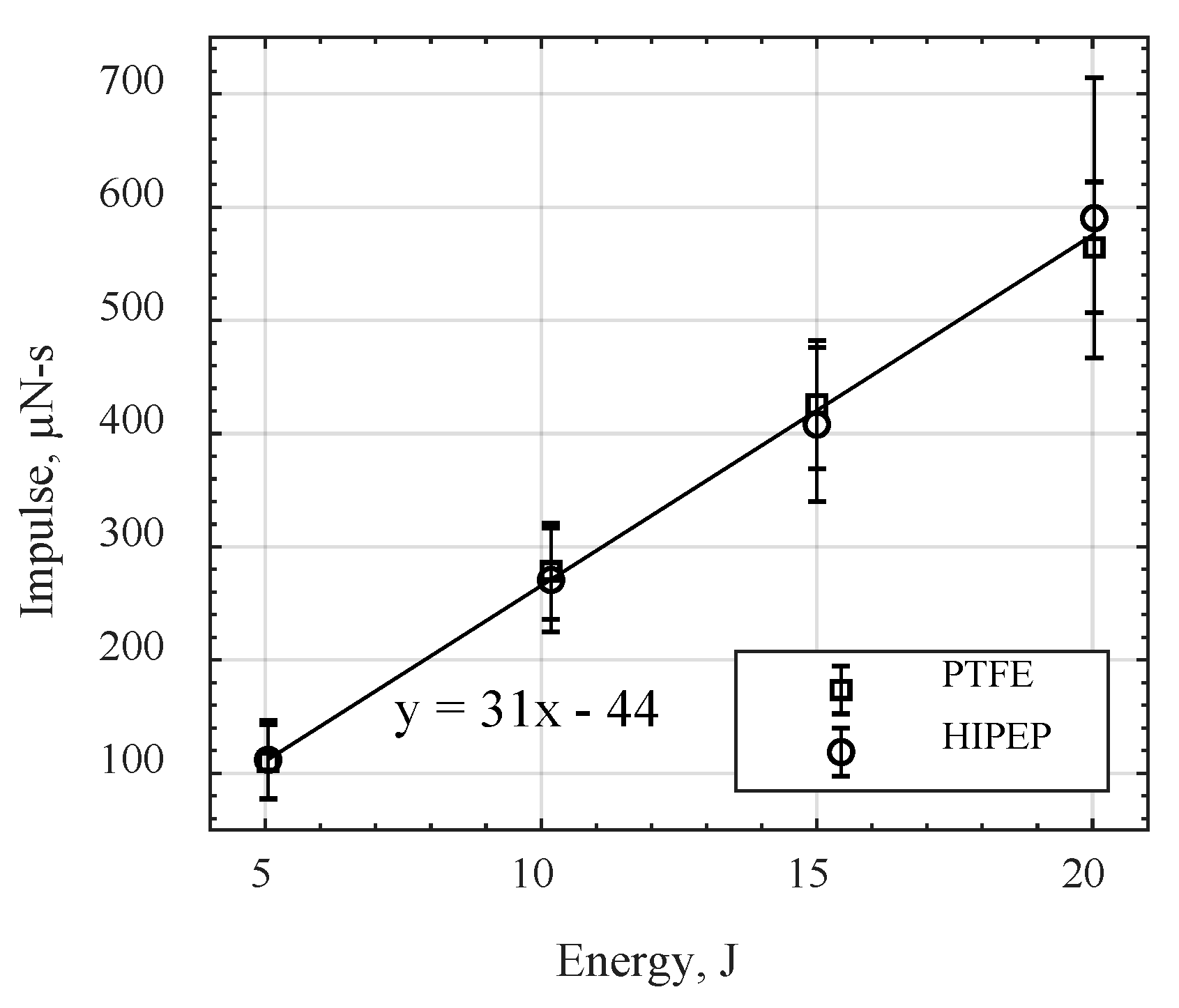
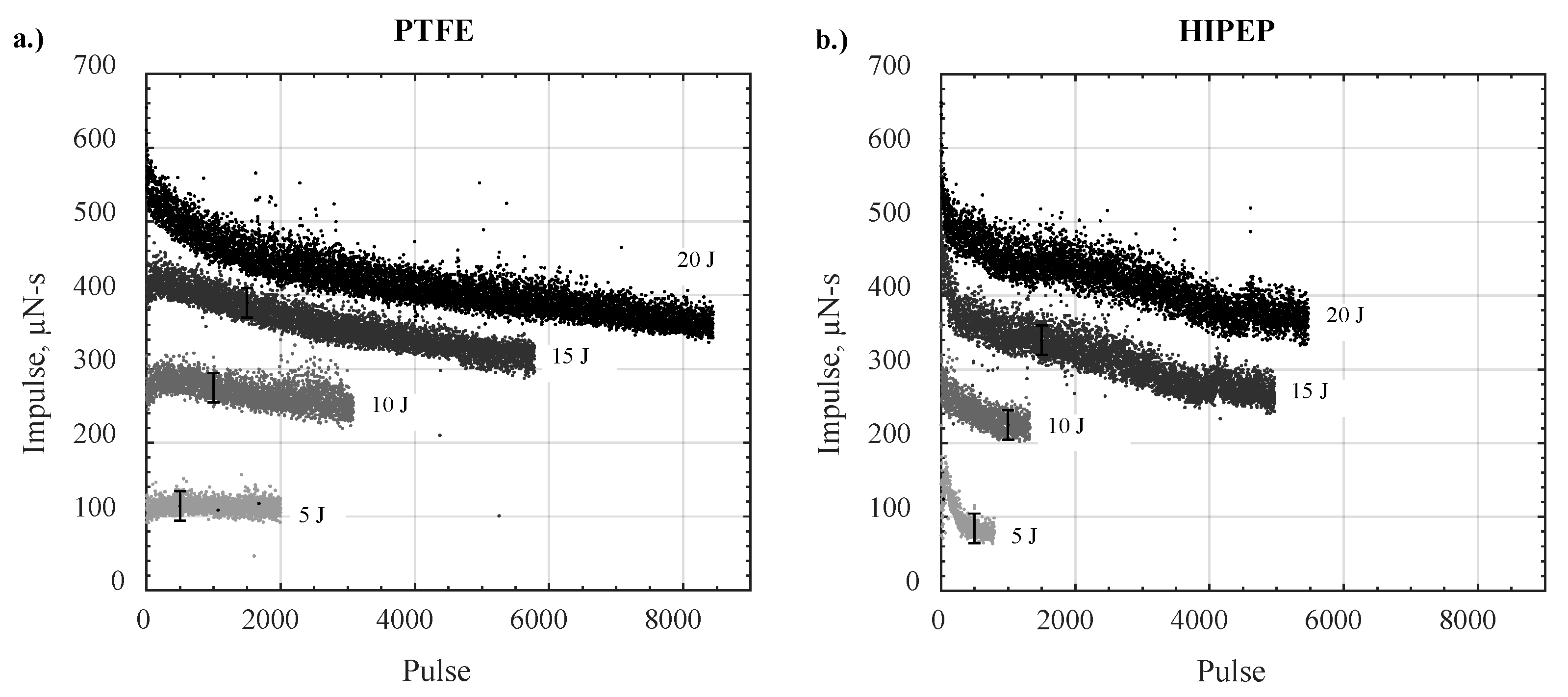
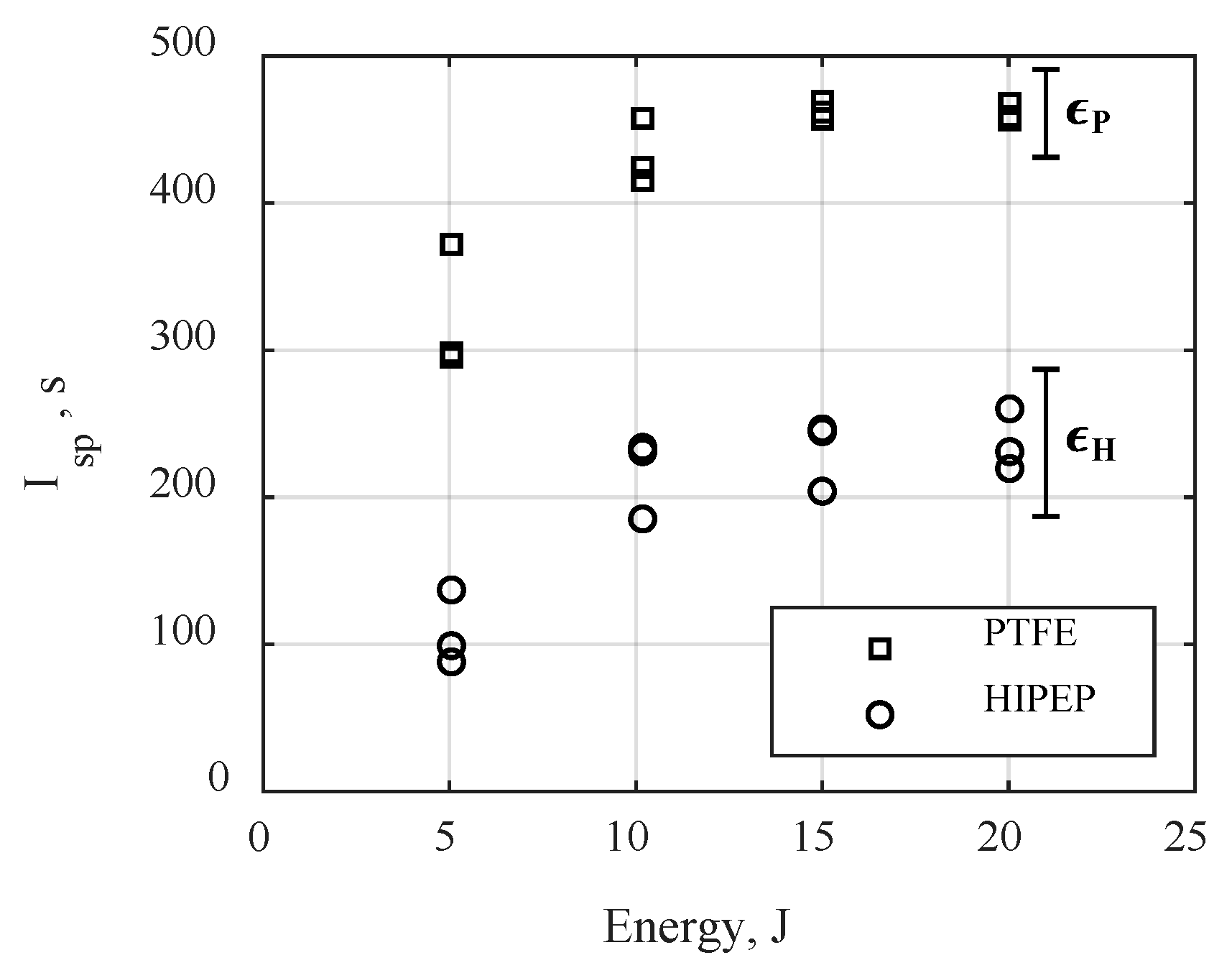
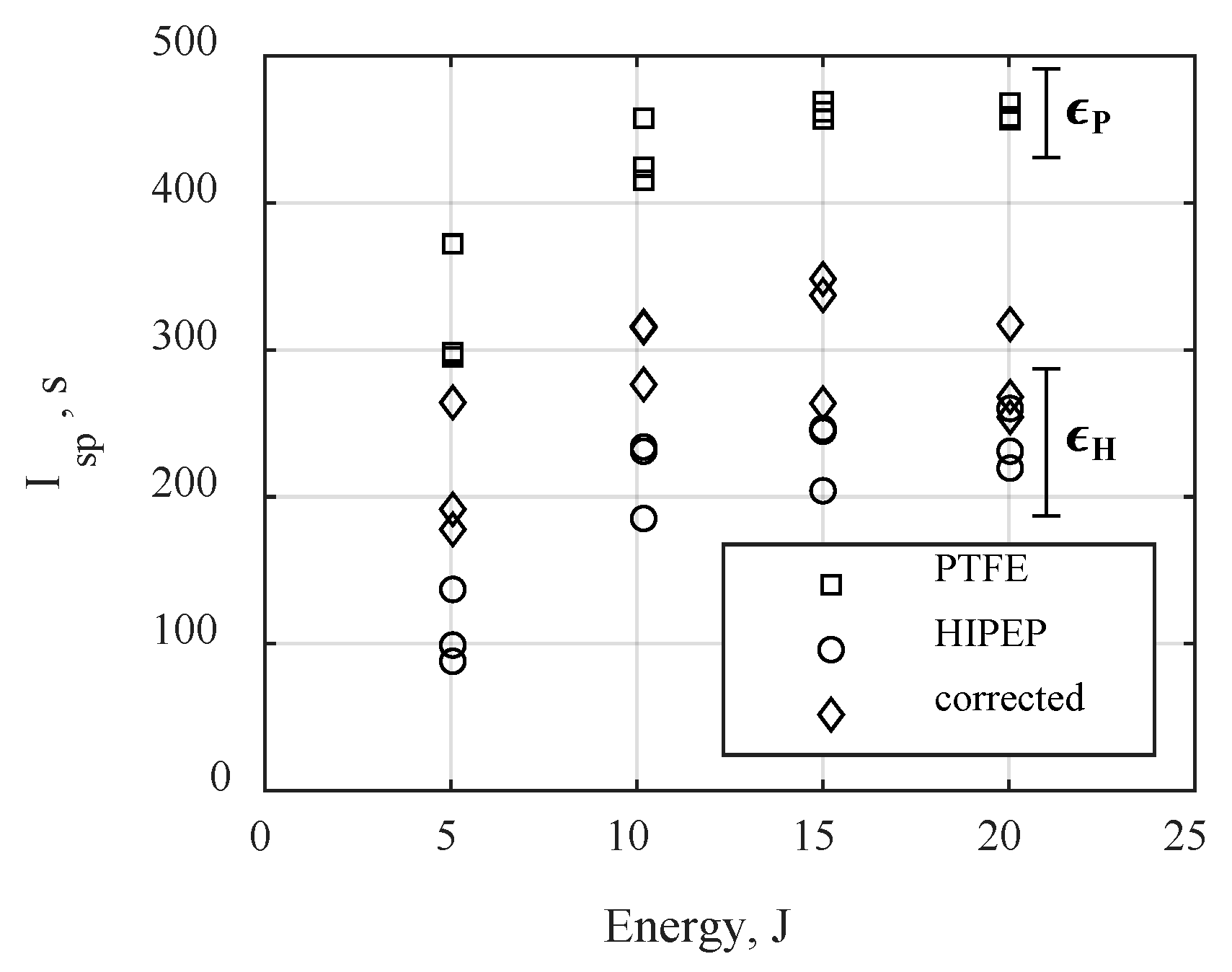
| Propellant | Energy, J | Total 10-Pulse Mass Loss, mg | Total 100-Pulse Mass Loss, mg | Ratio of 10-Pulse to 100-Pulse Mass Loss, % |
|---|---|---|---|---|
| PTFE | 5.05 | 0.37 | 3.53 | 10.5% |
| 10.18 | 0.70 | 6.91 | 10.1% | |
| 15.00 | 1.00 | 9.47 | 10.6% | |
| 20.03 | 1.28 | 12.48 | 10.3% | |
| HIPEP | 5.05 | 5.82 | 10.68 | 50.7% |
| 10.18 | 6.42 | 13.33 | 48.2% | |
| 15.00 | 6.02 | 18.43 | 32.7% | |
| 20.03 | 6.14 | 26.06 | 23.6% |
© 2020 by the authors. Licensee MDPI, Basel, Switzerland. This article is an open access article distributed under the terms and conditions of the Creative Commons Attribution (CC BY) license (http://creativecommons.org/licenses/by/4.0/).
Share and Cite
Glascock, M.S.; Rovey, J.L.; Polzin, K.A. Impulse and Performance Measurements of Electric Solid Propellant in a Laboratory Electrothermal Ablation-Fed Pulsed Plasma Thruster. Aerospace 2020, 7, 70. https://doi.org/10.3390/aerospace7060070
Glascock MS, Rovey JL, Polzin KA. Impulse and Performance Measurements of Electric Solid Propellant in a Laboratory Electrothermal Ablation-Fed Pulsed Plasma Thruster. Aerospace. 2020; 7(6):70. https://doi.org/10.3390/aerospace7060070
Chicago/Turabian StyleGlascock, Matthew S., Joshua L. Rovey, and Kurt A. Polzin. 2020. "Impulse and Performance Measurements of Electric Solid Propellant in a Laboratory Electrothermal Ablation-Fed Pulsed Plasma Thruster" Aerospace 7, no. 6: 70. https://doi.org/10.3390/aerospace7060070
APA StyleGlascock, M. S., Rovey, J. L., & Polzin, K. A. (2020). Impulse and Performance Measurements of Electric Solid Propellant in a Laboratory Electrothermal Ablation-Fed Pulsed Plasma Thruster. Aerospace, 7(6), 70. https://doi.org/10.3390/aerospace7060070






